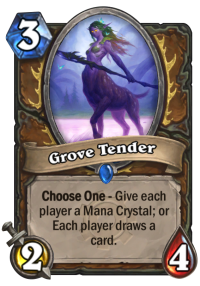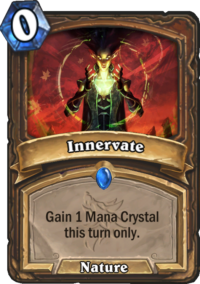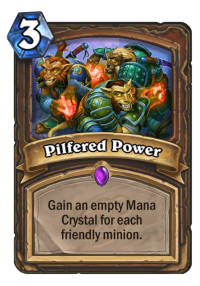Since time immemorial, playing Wild Growth on turn two was one of the best plays available to you in the game. Druid has always been the most consistent class in Hearthstone and it has recently become essentially omnipresent thanks to a wide variety of excellent cards dispersed across a multitude of sets. It’s tough to game out which part of its current toolkit pushes it over the edge to such extent that it’s got five or six viable archetypes with a very similar shell, but the common denominator of the rise of the current Standard builds has a lot to do with how reliable ramping has become even though the class wasn’t even given access to playable extra ramp tools so far in the current rotation.
Ancient Evils

While ramping is unique to Druid in the game, it also counts as a variation on Mt:G’s theme when it comes to resource collection. Hearthstone streamlines its inspiration’s system by providing one extra mana on your tray every turn while Magic requires you to specifically play out “land” cards to generate such resources. Sacrificing a card in your hand for present or future mana gain in an interesting mechanic, one which was always sparingly used: there are actually only three ramp cards available in the evergreen set (Innervate, Wild Growth and Nourish), and only nine other such ones were ever printed, some of which were never even close to competitive. Here’s looking at you, Astral Communion!
In fact, not even the inclusion of Wild Growth was a guaranteed choice for Druid decks in some of the previous metagames: the most aggressive archetypes of the class didn’t get enough benefit out of skipping turn 2 or ramping from five mana to seven. Perhaps the most notable example of this kind of a build is the hyper-aggressive deck from the Un’goro days that topped out at five mana with Living Mana and Bittertide Hydra: it was one of the main reasons behind the only nerf given to a ramp card to date.
Several powerful variations of Druid are currently seeing play, and all of them utilize Innervate. Innervate creates explosive starts to the game that can be difficult for the opposing player to recover from. This change leaves Innervate as a simple Basic card and slows down the explosive start potential, while ensuring that it will be utilized in decks that revolve around playing inexpensive spells.
What other changes did we consider?
We considered a few other options for Innervate:
- Refresh 2 Mana Crystals.
- Gain 2 Mana Crystals this turn only and increase the mana cost to 1.
- Gain 6 Mana Crystals this turn only and increase the mana cost to 4.
Since Innervate is a basic card, we need it to be clear and simple. Along with Wild Growth, these cards inform newer players that Druids create mana as a part of their class identity.
We kept in mind that cards like Counterfeit Coin were strong in combination with other support cards, such as Gadgetzan Auctioneer, Edwin VanCleef, and Combo cards. With the right support cards for Innervate, it may end up still seeing play, but won’t be in every deck—which is ultimately what we’re aiming for with this change.

The change to Innervate was actually quite controversial at the time and many considered it overkill: while it did create certain obnoxious turns even in slower decks, the main issue with it was the unexpected and uncounterable, instantaneous arrival of certain threats at a prohibitively early turn, rather than its two-mana-for-a-card ratio. Supposedly, the logical “refresh 2 mana crystals” solution was binned because its confusing nature and the fact that it wasn’t otherwise a mechanic in the game – Kun the Forgotten King would perhaps have something to say about that –: but whichever side of the debate you fall on, it’s clear that Innervate still has some fringe uses and that it wasn’t a game-breaking card even in its heyday. Besides, it’s still a horrendous topdeck in the lategame!
The Dangling Participant
There is an innate trade-off in the use of ramp cards – and perhaps the real issue is that doesn’t often come up in Hearthstone nowadays. Ramping gives you no immediate tempo benefit and costs you one card in your hand. It’s not guaranteed that you will actually have something to ramp into, meaning you can potentially run dry. This is why Nourish was almost never played in the pre-Standard days, and it’s no wonder that its first inclusion came at the same time as viable high-end tools were introduced to the card pool: once Whispers of the Old Gods rolled around, either C'Thun or Yogg-Saron, Hope's End that made such indiscriminate ramping a viable option, similarly to the role Ultimate Infestation plays now. Currently, the latter and Branching Paths makes it almost impossible to run dry on cards, allowing players to use Nourish almost exclusively as a ramp option.

Ramp as a mechanic was never overdone or innately broken – again, many such cards never saw serious play –: the main strength of the current Druid toolkit is that its stall options are so strong that you basically never get punished for skipping a set of turns. The really terrifying prospect is that you can spend the first four turns setting up a Spreading Plague and then gain enough armor in while your opponent chews through the beetles that the pass-Wild Growth-stall-Nourish is not just viable but one of the most desirable ones as a Druid player. Not even Jade Druid was this uninterested in keeping hold of the early board.
Based on the lack of balance changes, Team 5 clearly doesn’t think there’s any kind of serious issues with where the class is right now. In a big-picture sense, I’d be inclined to agree – and I also think that the anger directed at ramping options is misplaced. The real issue is that the downsides of ramping – skipping turns and losing cards – became completely meaningless thanks to the plethora of goodies made available to the class over the course of the last year and a half. Druid has always been playable and a viable tournament option no matter what the metagame was like: however, their strategies were never as discriminate and one-track as they are now. It’s not a question of mechanics: it is strictly down to card design.

Overload had its time to shine. Ramp is now having its time to shine. Still waiting for Discard to have its time to shine.
Quote: “I also think that the anger directed at ramping options is misplaced. The real issue is that the downsides of ramping – skipping turns and losing cards – became completely meaningless thanks to the plethora of goodies made available to the class over the course of the last year and a half.”
Amen to that.
Druid is balanced. I mean his ramp and late-game potential is good and usable once he reaches that point.But his lack of removal makes the early game vs aggro usually impossible to get thorugh without a good draw.
I know this is not mtg, but there you have green with lots of ramp, but green lacks a lot of things, that’s why it doesn’t feel so op.
The problem with druid is that it not only has ramp, it has everything else (drawing, removal, tokens, fatties, heal/armor)
really when did you last play magic? green in magic has ramp + token production + is home to fatties + is the second best colour at healing the only thing green doesn’t have as great removal (other than enchantment removal). the difference is that in Magic all the colours have multiple things they can do hearthstone doesn’t have that. if each hearthstone class had 3 or 4 viable things they could do then there wouldn’t be this much druid hate P.S. sorry for the bad formatting on a mobile device